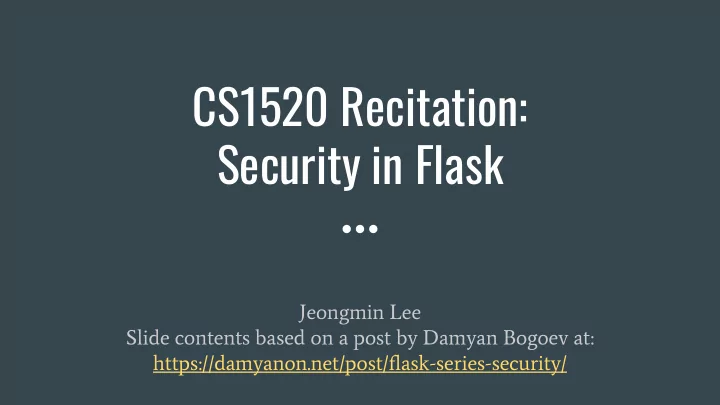

CS1520 Recitation: Security in Flask Jeongmin Lee Slide contents based on a post by Damyan Bogoev at: https://damyanon.net/post/flask-series-security/
Plan for Today ● XSS (Cross Site Scripting) ● CSRF (Cross-Site Request Forgery) ● SQL Injection ● Authentication and Authorization
Plan for Today ● XSS ● CSRF ● SQL Injection ● Authentication and Authorization
XSS ● Cross Site Scripting (XSS) ○ Attack that tries to have your websites or applications load malicious script in your browser
XSS ● Cross Site Scripting (XSS) ○ Attack that tries to have your websites or applications load malicious script in your browser ○ Try access user’s credentials, get cookie info, modify settings and download files etc.
XSS ● Cross Site Scripting (XSS) ○ Attack that tries to have your websites or applications load malicious script in your browser ○ Try access user’s credentials, get cookie info, modify settings and download files etc. ○ Can avoided by escaping text and validating user input.
XSS ● In Flask, by default it configures Jinja2 to auto escape all values loaded in the page. http://jinja.pocoo.org/docs/dev/extensions/#autoescap e-extension)
XSS ● More considerations for securing your applications w.r.t XSS: ○ avoid generating html without Jinja2
XSS ● More considerations for securing your applications w.r.t XSS: ○ avoid generating html without Jinja2 ○ avoid sending out data from uploaded files
XSS ● More considerations for securing your applications w.r.t XSS: ○ avoid generating html without Jinja2 ○ avoid sending out data from uploaded files ○ avoid using the Markup class on not verified data sent by a user
XSS ● More considerations for securing your applications w.r.t XSS: ○ avoid generating html without Jinja2 ○ avoid sending out data from uploaded files ○ avoid using the Markup class on not verified data sent by a user ○ always quote the attributes values in your templates.
Plan for Today ● XSS ● CSRF ● SQL Injection ● Authentication and Authorization
CSRF ● Cross-Site Request Forgery (CSRF) is an attack that uses the user’s authentication credentials to execute unwanted actions. ● To against CSRF, you can use random string and to verify it against a hidden field in post.
CSRF source: http://flask.pocoo.org/snippets/3/
CSRF ● Put this in your template: source: http://flask.pocoo.org/snippets/3/
Plan for Today ● XSS ● CSRF ● SQL Injection ● Authentication and Authorization
SQL Injection ● SQL Injection is an attack where users can inject SQL commands via user input form and have them executed on the server.
SQL Injection ● SQL Injection is an attack where users can inject SQL commands via user input form and have them executed on the server. ● This SQL query can be anything and can be very harmful.
SQL Injection ● SQL Injection is an attack where users can inject SQL commands via user input form and have them executed on the server. ● This SQL query can be anything and can be very harmful. ● Your application can be exposed to this attack when you dynamically create SQL statements. ○ e.g., concatenating data based on user’s input
SQL Injection ● By default SQL Alchemy quotes special characters – semicolons or apostrophes.
Plan for Today ● XSS ● CSRF ● SQL Injection ● Authentication and Authorization
Authentication and Authorization ● Authentication ○ verifies the user’s identity by validating his/her credential (username / email, password) ● Authorization ○ verifies whether authenticated user has access to a given resource
Flask-Security ● Flask-Security uses internally a User and Role data model, that could be defined via the SQL Alchemy API. ● You can inherit Flask-Security’s User and Role MixIn class to build your own.
roles_users = db.Table('roles_users', \ db.Column('user_id', db.Integer(), db.ForeignKey('user.id')), \ db.Column('role_id', db.Integer(), db.ForeignKey('role.id'))) class Role(db.Model, RoleMixin): id = db.Column(db.Integer(), primary_key=True) name = db.Column(db.String(80), unique=True) description = db.Column(db.String(255)) def __init__(self, name): self.name = name source: https://damyanon.net/post/flask-series-security/
class User(db.Model, UserMixin): id = db.Column(db.Integer, primary_key=True) email = db.Column(db.String(255), unique=True) password = db.Column(db.String(255)) active = db.Column(db.Boolean()) roles = db.relationship('Role', secondary=roles_users, backref=db.backref('users', lazy='dynamic')) def __init__(self, email, password, active, roles): self.email = email self.password = password self.active = active self.roles = roles source: https://damyanon.net/post/flask-series-security/
Flask-Security ● The User class derives from UserMixin Flask-Login default user implementation. Same for Role class. ● SQL Alchemy is used for both User and Role objects. ● Following configurations is added to use Flask-Login with SQL Alchemy
def configure_app(app): ... # Configure Security user_datastore = SQLAlchemyUserDatastore(db, User, Role) app.security = Security(app, user_datastore) ... ● Complete explanation of Flask-Security configuration is here: https://pythonhosted.org/Flask-Security/configuration.html source: https://damyanon.net/post/flask-series-security/
Questions?
Recommend
More recommend